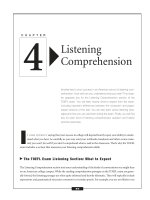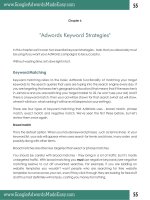Chapter 6: Listening comprehension tests pptx
Bạn đang xem bản rút gọn của tài liệu. Xem và tải ngay bản đầy đủ của tài liệu tại đây (116.57 KB, 22 trang )
Chapter 6:
Listening comprehension tests
I. General
Careful selected practice material
an effective way of developing listening skill
used for testing listening comprehension
an awareness of ways in which the spoken
language differs from the written language is
crucially important in testing listening
comprehension skills
some conventional features such as
repetition, hesitation and grammatical
patterns are essential for the understanding
of spoken English
the tape recorder is the only way of ensuring
compete uniformity of presentation and thus
a high degree of reliability
auditory tests are divided into two broad
categories: (i) tests of phoneme
discrimination and of sensitivity to stress
and intonation, and (ii) tests of listening
comprehension
II. Phoneme discrimination tests
Type 1: The test consists of a picture,
accompanied by three or four words spoken by
the examiner in person or tape.
Type 2: The testees hear three sentences and
have to indicate which are the same and which
are different.
Type 3: Testees are required to choose the
written word which corresponds to the spoken
word.
Notes
These items
used for diagnostic testing
purposes, enabling the teacher to concentrate
later on specific pronunciation
They
useful when candidates having the
same L1 background & when a contrastive
analysis of L1 & L2 can be used.
The ability to discriminate between certain
phonemes
very difficult for native speakers.
III. Tests of stress and intonation
Tests of stress and intonation: less
satisfactory than the phoneme discrimination
tests b/c of # reasons:
Most tests are impure as they test other
skills at the same time.
These items are artificial as they test
rarer but more testable features.
IV. Statements and dialogues
These tests designed to measure:
how well students can understand
short samples of speech
how well they deal with a variety of
signals on lexical and grammatical
levels of phonology
TYPE 1
included in a grammar test, reading
test or listening test , depending on
whether the item is written or spoken
testing ability to understand both
the grammatical and lexical features
of a short utterance. (Candidates
hear a statement and choose the
best option from the four ones)
TYPE 2
These items are an attempt to simulate
speech situations (so they are more
satisfactory that those of type 1)
Testees listen to a short question and
have to select the correct response from a
choice of four printed ones. (part II,
TOEIC)
V. Testing comprehension
through visual materials
These item types
more appropriate
for the elementary stages of learning
English.
Pictures, maps and diagrams
used
effectively for testing.
Testees’ performance: less dependent
on other skills like reading & speaking
and vocabulary
TYPE 1
a picture is used in conjunction
with spoken statements.
testees listen & pick out true &
false statements.
(page 71)
TYPE 2
there are five pictures in front of
testees; they listen to 4
statements & they’re required to
choose the appropriate picture
being described
(page 72)
TYPE 3
used in a number of listening tests
testees see a set of three or
four pictures
they hear a statement & choose
the most appropriate picture
being described (page 73)
TYPE 4
Simple diagrams (lines,
squares, rectangles, circles &
triangles) used in a test of
elementary comprehension
Candidates look at each of the
4 diagrams and then hear a
series of statements about
each diagram (page 73)
TYPE 5
used to access testees’ ability to
understand instruction
e.g. Tasks in C4 Interactions I
maps can be used or adapted for
testing (p.74-75)
TYPE 8 & 9
used to test students’ ability to identify
and classify information (see example
on p.81)
simple paper-folding and drawing can
also be used to measure learners’
ability to understand instruction
Useful for ordinary classroom
purposes, but difficult to administer in
public exams
VI. Understanding talks and lectures
Items of this type
very common & used to test
students’ ability to understand
both informal talks and formal
lectures –an important skill
English learners at intermediate
and advanced levels
TYPE 1 & 2
Testees listen to a short talk &
select the correct answer about
the talk
Testees listen to a short talk &
read a summary containing
blanks; then they must complete
the blanks (pages 82-83)
TYPE 3&4
Hearing a short talk or lecture &
answering questions on it
e.g. multiple – choice items, true/false
items & incomplete sentences
the content of the text itself
determine the type of item
Notes
(1) Completion
not recommended
as testees facing with the tasks of
listening, reading and writing
simultaneously- an extremely
difficult task even for native
speakers
Notes
(2) Multiple – choice items may
cause confusion because testees
have to listen while reading all
options carefully to make their
selection
Notes
(3) It’s best to use true/false
items since this reduces the
amount of reading and
selection to be made.









